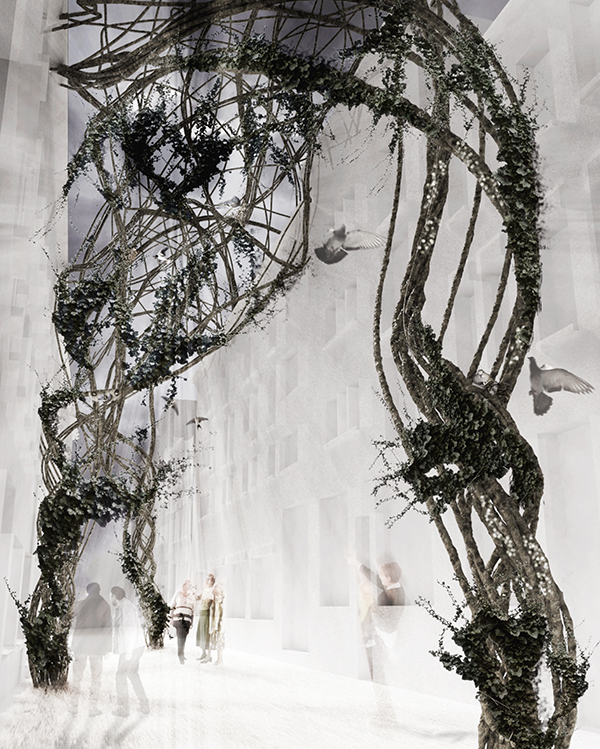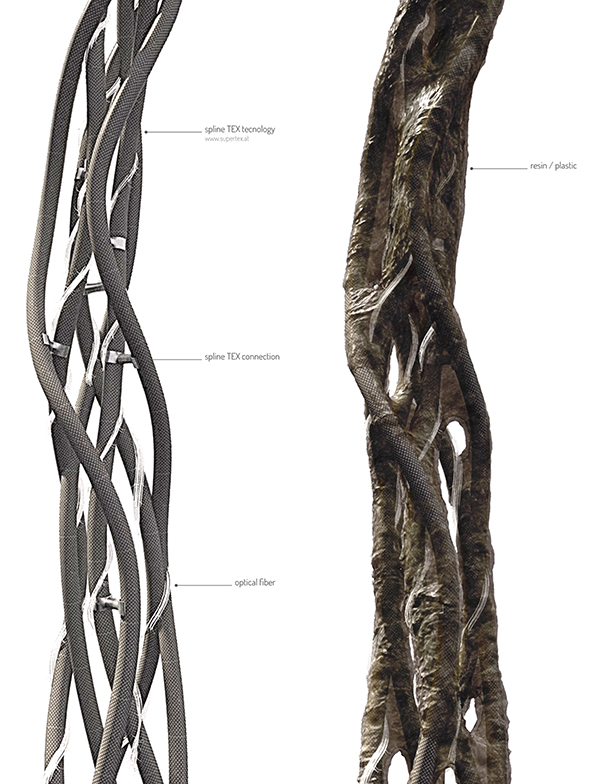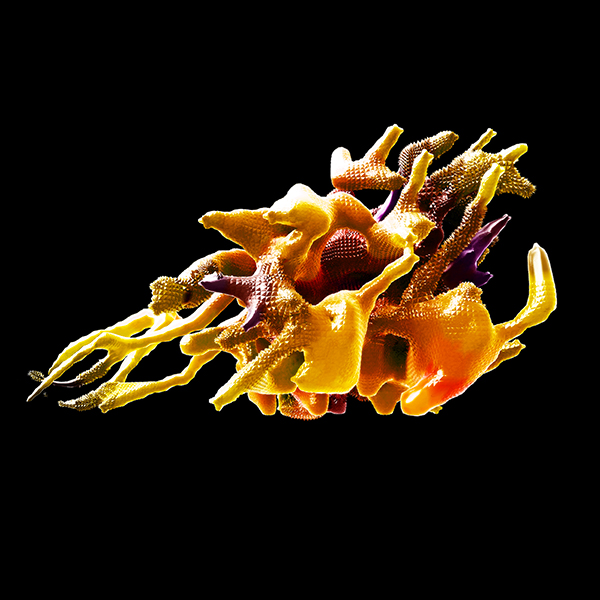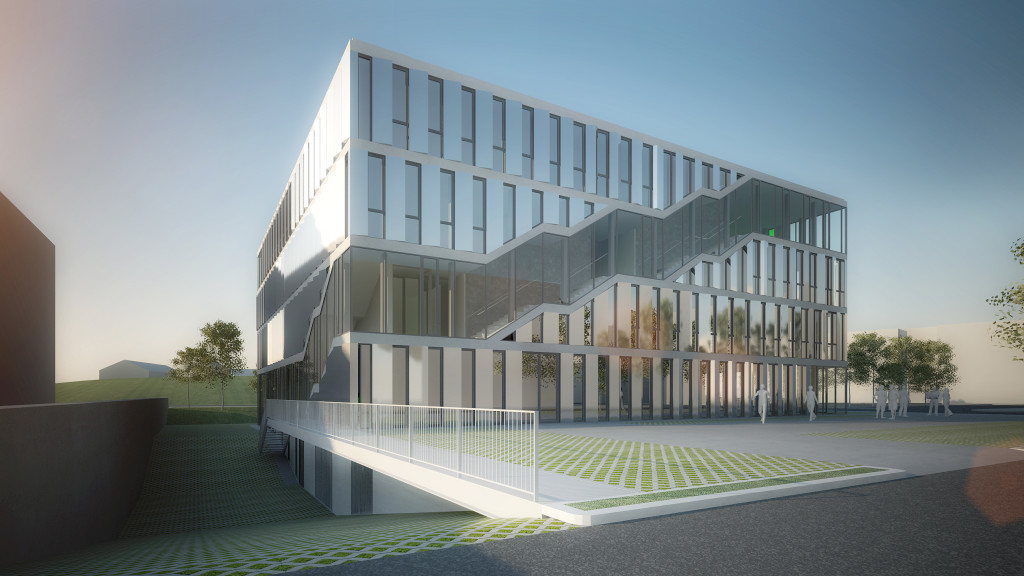MD+MB// Disguincio&CO

interview with Disguincio&Co by Davide del Giudice
(DDG) : I’m interested in your architecture, especially where the individual parts are no longer recognizable, no longer allowing a differentiation between structure, membrane, skin, an architecture like a sensitive creature with relations to external and internal agents (chemical, bacteria, climate…).The interfaces between architecture, neurobiology and mathematics are modern territories of exploration and the negotiation (robotic behavior, computation protocols, chemical bio-polymer…), become the substrate of your aesthetic. Designers have a long history in borrowing tools and techniques from other disciplines, they visualize a specific futuristic scenario and aim to approach it through the help of technology and the collaboration with scientists. How do you use this revolutionary appropriation in your practice and research?
(M&M) : We try to conceive every project (to metabolize, not to create), as a system involved into the inCORPOration of its parts, thinking with morphology, matter and technology. Often it’s just the curiosity about particular technologies or materials that suggests a research path that materializes itself into architecture. Recent biotechnological scenarios are opening interesting perspectives in architecture, it is a real cultural leap, to which we have to prepare ourselves. As architects we feel the responsability to carry possible scenarios of development. We feel close to this vision of sensitive architecture, a system able to respond to external stimuli, a system that mutates, that modifies itself, that interacts with the space and the surrounding environment. The architectural object is used, consumed, transformed by climatic, organic and social agents; often we see buildings decaying in a passive way, rather than thinking about architecture as a freezing of a shape in a particular moment, we try to think about materials that can grow, regenerate themselves, transform themselves: we want the building to consume itself, it must be part of a metabolic process. The robots are part of our cultural landscape. Using a robot to build, repair or modify a building, is not a fantasy of a passionate of sci-fi, it is a political intention, an innovation will, that will have an actual benefit on human beings. We are certainly fascinated by the technical complexity that comes with its design, but the focusing concept is the embodyment of robots in the design process and the architecture itself, in different forms and ways. Speaking concretely, in the industrial reality of everyday life, we relate with the manufacture of CNC components, with the creation and implementation, therefore, of parts of the project ready for the assemblage, robotics is involved in maintenance or simply in the life of the building. Next step will be to design “biological work system”, biological robots (robota, “forced labor”), considering the architecture itself as a robot that self-repairs, that has a life cycle. In a contemporary society, where technology makes it easier to establish relationships with experts from the other side of the world, the only brake is our current physicality. We want to take advantage of the opportunities that technology makes available to us, it would be anachronistic to avoid it, the impetus to collaboration is inherent in the historical moment in which we live, it is a natural consequence, an emergent behavior. We still have to adapt properly. All this allows us to construct an architectural project as a collaboration between experts of different disciplines, often seemingly unrelated or irreconcilable, towards a synthesis of knowledge and the dissolution of pure discipline. A cannibalization of knowledge, training us in collecting, combining and transforming: taking something of existing and setting up the logic of change to explore opportunities in the creation of the Other.
(DDG) : Our interest is never focused on technique or in a veneration of scripting, instead our focus has been on methodologies that generate complex systems and emergent outcomes. It seems evident that in recent years an obsession with parametric tools has born, although there keeps on being a misunderstanding of the terms generative, parametric, algorithmic, computational and scripting. I consider parametric and emergent as polar opposites. Within parametric hierarchical tools all possibility is given within the starting condition, while emergent conditions arise from non-linear systems such as multi-agent models. Algorithms often work in a deterministic way, where there is a linear relationship between the input and output and often this does not have the sophistication to enable you to embed any architectural concern within the process. What do you think about that?
(M&M) : My interest in your work is related to the intention of the designer and how it is embedded in the procedural or algorithmic process and how this intent self-organizes as opposed to simply criticizing the output of these processes. In my opinion the ability to produce purpose is the foundation of the design process. What do you think about that? We like the the use of the term “intention”, design is the first signal of human intention (McDonough). The physical, biological, social characters are the humus to build up the logic of the project, precisely the intention, trying to catch the crack that will allow you to push the architecture in the flow: we consciously understand architecture as a re-configuration of the landscape (mental, social, physical, …). The project must have the ability to open doors, to ask new questions and then give the possibility to continue a cycle, not close it, the goal is not to find only solutions. Back to the technical issue, our obsession is the simulation. To assemble, if not build, different tools in the preparation of a device in order to analyze and understand a process in its development, as it unfolds. Then, parameters, algorithms, scripts, are nothing but a part of everything, they are part of the tools that are used to create the relationships of the system, which represents the intention of the project. We use them in a very utilitaristic manner, without losing touch with the realities of production, with the physical manifestation. We do not speak about simulation being an end in itself, but as a connection with the making process. As we said before, we are interested in the use of simulation as a tool for the generation of the Other, as a device capable of altering the origin and building a new one, in a continuous becoming: the simulation becomes the engine of the mutation from the inside, a tool to explore the not-known, non-imaginable, a series of strategies for the exploration of intermediate, vague and uncertain processes. Through the definition of intention, we try to drive the output, there is still a kind of soft boundary that separates what is controlled and what is not controlled in our projects: the overall behavior is part of a strategic plan, in the design intent, the detail fluctuates in the range of the possible, settling on it’s own in a position, emerging, not precisely predictable. This can be achieved in different ways, one of the strategies that we are now trying to use, involves the exploitation of the incompleteness of the system, or on the other hand, to use as an engine of change, the incomplete information array of a simulative system.

(DDG) : Mi interessa la vostra architettura, soprattutto quando le singole parti non sono più riconoscibili, non consentendo una differenziazione tra struttura, membrana, pelle, un’architettura come una creatura sensibile, con relazioni con agenti esterni e interni (chimici, i batteri, il clima …). Le interfacce tra architettura, la neurobiologia e la matematica sono territori moderni di esplorazione e la negoziazione (comportamento robotico, protocolli di calcolo, chimico bio-polimero …), diventano il substrato della vostra estetica. I progettisti hanno una lunga storia nel prendere in prestito strumenti e le tecniche da altre discipline, essi visualizzano uno specifico scenario futuristico e mirano ad avvicinarsi attraverso l’aiuto della tecnologia e la collaborazione con gli scienziati. Come usate tale stanziamento rivoluzionario nella pratica e nella ricerca?
(M&M) : Cerchiamo di concepire ogni progetto (metabolizzare, non creare), come un sistema propenso all’inCORPOrazione delle parti, ragionando con morfologia, materia e tecnologia. Spesso è proprio la curiosità nei confronti di particolari tecnologie o materiali che suggerisce un percorso di ricerca che poi si materializza in architettura. Gli scenari che si stanno aprendo in ambito biotecnologico, lasciano intravedere interessanti prospettive in campo architettonico, un vero e proprio salto culturale, a cui già da ora dobbiamo prepararci. Come architetti sentiamo la responsabilità di veicolare possibili scenari di sviluppo. Ci sentiamo particolarmente vicini a questa visione di un’architettura sensibile, un sistema che risponda agli stimoli esterni, un sistema che muta, si modifica, interagisca con lo spazio e l’ambiente che lo circonda. L’oggetto architettonico viene usato, consumato, trasformato da agenti climatici, organici e sociali; spesso vediamo edifici che si degradano in modo passivo, cerchiamo quindi, di non pensare all’architettura come congelamento di una forma in un determinato istante, piuttosto siamo interessati all’impiego di materiali che possano crescere, rigenerarsi, trasformarsi: vogliamo che l’edificio si consumi, deve essere parte di un processo metabolico. I robot fanno parte del nostro paesaggio culturale. Costruire, riparare o modificare un corpo architettonico, tramite l’uso di robot, non è una fantasia da appassionati di fantascienza, è un’intenzione politica, è una volontà di innovazione, di vero e proprio beneficio per l’essere umano. Siamo certamente affascinati dalla complessità tecnica che accompagna la sua progettazione, ma il concetto che ci interessa è l’incorporazione di robot nel progetto e nell’architettura, in forme e modalità diverse. Parlando concretamente, nella realtà industriale del quotidiano, ci relazioniamo con la fabbricazione CNC di componenti, con la realizzazione e messa in opera, quindi, di parti del progetto per l’assemblaggio, la robotica poi, interviene nella manutenzione o semplicemente nella vita dell’edificio. Il passo successivo sarà quello di progettare “sistemi biologici da lavoro”, robot (robota, “lavoro pesante”) biologici, considerando l’architettura stessa come robot, che si auto-ripara, che ha un ciclo di vita. In una società contemporanea, dove la tecnologia permette di instaurare più facilmente rapporti di collaborazione con esperti dall’altro capo del mondo, l’unico freno è la nostra attuale fisicità. Vogliamo comunque approfittare delle possibilità che la tecnologia ci mette a disposizione, sarebbe anacronistico non farlo, l’impulso alla collaborazione è congenito al momento storico che viviamo, è una naturale conseguenza, è un comportamento emergente, se vogliamo. Dobbiamo ancora adattarci. Tutto ciò permette di costruire un progetto architettonico come collaborazione tra esperti di diverse discipline, spesso apparentemente distanti o inconciliabili, verso una sintesi del sapere e verso la dissoluzione della pura disciplina. Una cannibalizzazione del sapere, allenandoci nel collezionare, combinare e trasformare: prendere qualcosa di esistente e allestire delle logiche di mutazione e sondare le possibilità nella creazione dell’Altro.
(DDG) : Il nostro interesse non è mai focalizzato sulla tecnica o nella venerazione dello scripting, invece la nostra attenzione si è concentrata sulle metodologie che generano sistemi complessi e dei risultati emergenti. Sembra evidente che negli ultimi anni una ossessione sugli strumenti parametrici è nata, anche se continua ad esserci un fraintendimento dei termini generativo, parametrico, algoritmico, computazionale e scripting. Ritengo parametrico ed emergente come opposti polari. All’interno di strumenti parametrici gerarchici ogni possibilità viene data entro la condizione di partenza, mentre le condizioni emergenti derivano da sistemi non lineari, come i modelli multi-agente. Gli algoritmi spesso lavorano in modo deterministico, dove c’è una relazione lineare tra ingresso e uscita, e spesso questo non ha la sofisticazione per consentire di incorporare qualsiasi problema architettonico all’interno del processo. Il mio interesse per il vostro lavoro è legato all’intenzione del progettista e come si è integrato nel processo procedurale o algoritmico come questo intento si auto-organizza in contrapposizione al semplice criticare l’ output di questi processi. A mio parere la capacità di produrre scopi è il fondamento del processo di progettazione. Cosa ne pensate?
(M&M) :Ci piace il fatto che usi il termine “intenzione”: il design è il primo segnale dell’intenzione umana (McDonough). Le caratteristiche fisiche, biologiche, sociali costituiscono l’humus per costruire le logiche del progetto, l’intenzione appunto, cercando quello spiraglio che permetterà di inserire l’architettura in quel flusso: vogliamo consapevolmente intendere l’architettura come ri-configurazione del paesaggio (mentale, sociale, fisico, …). Il progetto deve avere l’abilità di aprire porte, di porsi nuove domande e quindi dare la possibilità di continuare un ciclo, non di chiuderlo, l’obiettivo non è quello di trovare esclusivamente delle soluzioni. Tornando alla questione tecnica, la nostra ossessione è la simulazione. Assemblare, se non costruire, diversi tools nell’allestimento di un dispositivo al fine di analizzarlo e quindi comprendere un processo nel suo sviluppo, nel suo divenire. Quindi parametri, algoritmi, script, non fanno altro che essere parte del tutto, sono parte dei tools che servono a creare le relazioni del sistema, che rappresenta l’intenzione del progetto. Ce ne serviamo in modo utilitaristico, senza perdere il contatto con la realtà produttiva, con la manifestazione fisica. Non parliamo dunque di simulazione fine a se stessa, ma come contatto con il fare. Come dicevamo prima, siamo interessati nell’utilizzo della simulazione come strumento per la generazione dell’Altro, come dispositivo capace di alterare l’origine e costituire una nuova origine, in un continuo divenire: la simulazione diventa motore della mutazione dall’interno, un mezzo per sondare il non-conosciuto, il non-immaginabile, strategie per l’esplorazione di processi intermedi, vaghi, incerti. Attraverso la definizione dell’intenzione, cerchiamo di guidare l’output, c’è comunque una sorta di confine morbido che separa ciò che è controllato e ciò che non è controllato nei nostri progetti: il comportamento generale rientra in un piano strategico, nell’intenzione progettuale, il dettaglio, fluttua nel range del possibile, stabilendosi in modo autonomo in una posizione, emergente, appunto non prevedibile. Questo può essere raggiunto in modi diversi, una delle strategie che ora stiamo cercando di utilizzare prevede lo sfruttamento dell’incompletezza del sistema, ovvero utilizzare come motore del cambiamento l’incompletezza delle informazioni di un sistema simulativo.
Related Posts :
Category: Article
Views: 2236 Likes: 2
Tags: algoritmo , architettura , architettura parametrica , davide del giudice , design , interview , script , script parametrico
Comments:
Info:
Info:
Title: MD+MB// Disguincio&CO
Time: 5 giugno 2012
Category: Article
Views: 2236 Likes: 2
Tags: algoritmo , architettura , architettura parametrica , davide del giudice , design , interview , script , script parametrico






